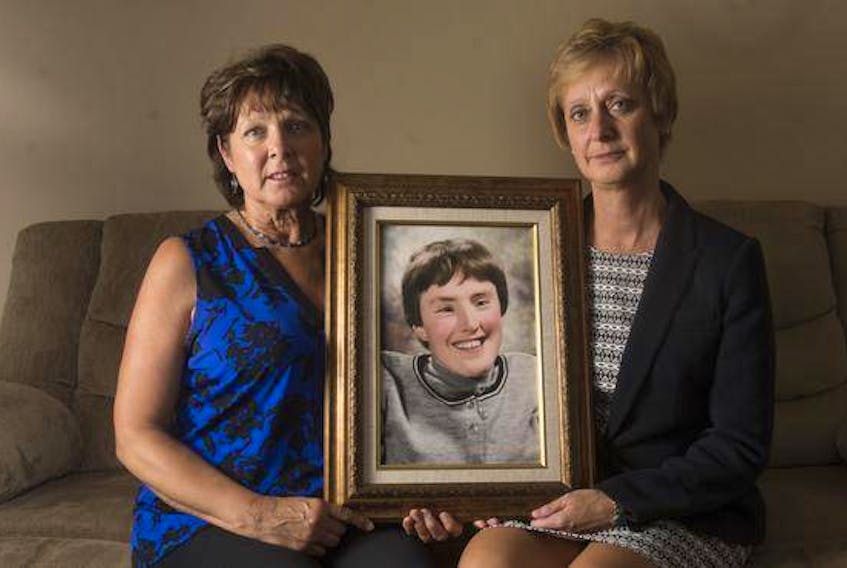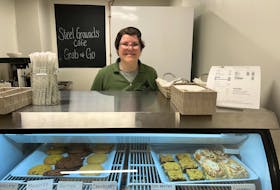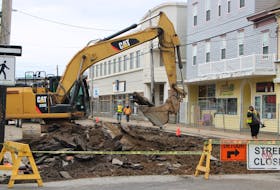EDITOR’S NOTE: Descriptions included in this story and an image published with it may offend some readers. Chrissy Dunnington’s foster family wanted readers to see the powerful image of the pressure ulcer that led to her death.
By Jennifer Henderson
“What happened to Chrissy shouldn’t happen to anyone,” says Dorothy Dunnington. “Somebody is responsible for Chrissy’s death and we want accountability.”
Dorothy is one of Christine (Chrissy) Dunnington’s five older sisters. They remember her love for music (singing along with The Backstreet Boys) and her extensive collection of Barbie videos.
Chrissy was born with spina bifida and hydrocephalus, which led to brain damage and confined her to a wheelchair. From the age of six weeks, she was loved and cared for by her foster parents until her 84-year-old foster mother became ill.
Her sisters say 38-year-old Chrissy was a healthy woman with a disability when she was admitted as a resident at Parkstone, a Shannex residence in Halifax, in October 2016. They say they were “thrilled” to get a place in a beautiful building near her foster parents. But her family never imagined that 17 months later Chrissy would be dead from infection or (what the attending physician told the family was) sepsis caused by a Stage 4 pressure ulcer, or bedsore.

Chrissy was sent by ambulance to the emergency department of the Queen Elizabeth II Health Sciences Centre on Jan. 28, 2018, after her parents and another sister found her dehydrated and struggling for breath. They insisted she receive medical attention. Parkstone called paramedics and Chrissy was treated for septic shock and pneumonia. Hospital staff advised the family that the infection was so serious she might not survive. Despite the horrible smell, Chrissy’s sister Elizabeth Deveau says she was completely unprepared for what she saw when staff removed a bandage from her sister’s lower back.
“It was traumatic. We were in shock to see it,” recalls Elizabeth, shuddering.
“The wound was the size of your fist and three centimetres deep. You could see her tailbone.”
Chrissy remained in hospital for another eight weeks, but the wound never healed and she did not respond to treatment.
Her sisters claim they were blindsided by the severity of the wound and question why the attending doctor at Parkstone had not called in a specialist before the pressure ulcer became untreatable. Members of Chrissy’s family had visited her at the nursing home every two days and say prior to the emergency they had been told Chrissy had “a small sore” or “abrasion” on her back that was healing well.
Dorothy and Elizabeth believe the situation was preventable. Within two months of her arrival at Parkstone, they met with staff and documented their concerns that Chrissy was spending too much time in bed and was at risk of developing a bedsore because of being improperly positioned in her wheelchair. Chrissy was unable to move herself and the policy at Parkland forbids staff from lifting, so they rely on a mechanical lift to move residents from their bed to the chair.
“However she landed in the morning, that’s how she spent her day,” says Elizabeth.
The family believes poor positioning in her custom-built wheelchair led to an earlier trip to emergency in September of 2017. Chrissy had recently been diagnosed with breast cancer, but the medical oncologist referred her to emergency because he was concerned about one leg swollen to three times its normal size. The diagnosis was cellulitis from a pressure ulcer on her heel.
Shannex, the company that owns Parkstone and more than 30 nursing homes in the Maritimes, says Nova Scotia’s Privacy Act prevents the company from discussing individual cases. But it did respond to a question about what steps it is taking to prevent future deaths from pressure ulcers.
“In the past twelve months, we have updated our best practice guideline to ensure we are providing the highest standard of care with respect to wound prevention and management,” wrote Catherine MacPherson, Shannex’s vice-president of operations enhanced care. “In addition, this year, two members of our clinical team will enrol in an intensive and internationally recognized wound care training program, so they can provide ongoing, in-house training and support to all sites.”
This disturbing story is further complicated by legal and ethical issues. Despite spending her entire life in the Dunnington family, Chrissy was never legally adopted.
When Chrissy went into septic shock, the hospital informed the family there was a Do Not Resuscitate (DNR) order beside her name. The family knew nothing about it and later learned Shannex had made the designation based on its policy in the Shannex Enhanced Care Handbook. On page 14 it states: “You may have completed a Personal Directive prior to admission into the home. This legal document should be consulted when making a Pathway choice. For those who choose no CPR or if there is no signed Pathway of Care document, resuscitation will not be initiated, and you will be allowed a natural death.”
Chrissy Dunnington was not capable of making that decision, and because she was not legally adopted, Shannex may have had no legal obligation to consult her foster family. Her substitute decision-maker was the Office of the Public Trustee. The family followed up with the office and says they were told that nobody from Shannex had ever called to request a DNR order for Chrissy. When The Chronicle Herald asked the Public Trustee to verify that, we received this email from Sarah Gillis of the Nova Scotia Justice Department:
“The office policy is that the Public Trustee, in her capacity as Substitute Decision Maker of last resort, does not sign DNR (Do Not Resuscitate) orders for any of their clients.”
Shannex declined to comment on whether it had checked with the Office of the Public Trustee.
It also sidestepped a question asking which legal authority or legislation underpins its DNR policy. MacPherson of Shannex emailed, “With respect to your question about end of life care, we approach these discussions with all residents and/or their legal decision makers in a compassionate manner at the time of their admission. This discussion results in a decision by each resident’s legal decision-maker about their goals of care at end of life.”
Dr. Jocelyn Downie, a nationally respected ethicist at Dalhousie University’s Health Law Institute, says if the company didn’t check with the Public Trustee, in her opinion placing a DNR order would be “indefensible.”
“I do not believe that it is legal to unilaterally withhold or withdraw potentially life-sustaining treatment (including CPR) from a patient (barring the exceptional circumstance in which CPR clearly will not work as opposed to being judged by someone as not benefiting the patient),” says Downie. “Rather, the institution should have sought consent to the DNR from the Public Trustee as this patient’s legal substitute decision-maker.”
Dorothy Dunnington says she was “enraged” to discover Parkstone had placed a Do Not Resuscitate order beside Chrissy’s name.
“We had a healthy 38-year-old woman go in there who had DNR on her file because she is not capable of signing a personal directive herself and no one was asked to do it for her,” she says, tearing up at the memory. “I wonder if her care would have been different had they not felt that’s where she was headed. Did they not care she was dehydrated or that her wound was getting infected because they considered her DNR? I don’t know the answer.”
The family alleges Chrissy’s care was negligent and is considering asking the police to determine if there is enough evidence to lay charges for “failing to provide the necessities of life.” Meanwhile, the Dunningtons laid a complaint with the government under the Protection of Persons in Care Act (PPCA) three months ago. The Department of Health, which regulates 94 nursing homes in the province, is also awaiting those findings.

“This is a tragedy,” says MJ MacDonald, the executive director for continuing care at the Department of Health. “We are looking forward to getting to the root cause and applying corrective measures. We are working closely with the sector to ensure it won’t happen again and reassure families this is not acceptable.”
MacDonald says the department is currently reviewing the mix of staff in nursing homes to see if more nurses are needed, but that process may take “a year or two” to complete. She says one potential outcome might be to assign registered nurses with specialized wound-care training, who are working elsewhere in the health system, to provide training in nursing homes, a measure professional nursing organizations have been advocating.
In the face of growing urgency, that response may be too slow. Chrissy Dunnington passed away just six months after 93-year-old John Ferguson, a resident of the Shannex Harbourstone home in Sydney, died from sepsis. Five complaints about bedsores in long-term care homes have been made in the past year. The Ferguson family’s complaint is still being examined under the Protection of Persons in Care Act.
Two other investigations that did not involve deaths have finished. Directives to make changes were issued to those two nursing homes, according to Robert Lafferty, manager of investigation and compliance at the Department of Health. Both the identities of those homes and the changes they were ordered to make remain secret until they can be unsealed through a freedom of information request.
It is tempting to think care might improve if, like restaurant health inspections, the results of nursing home inspections were posted online for the public. Licence withdrawals in the sector are rare. Families generally don’t sue homes because current legislation awards damages based only on lost income of the resident. With elderly or disabled patients, there is most often only a fixed income. Added to that, the demand for nursing home beds (more than 1,000) means homes have no financial incentive to increase staffing ratios or change policies.
In Ontario, families of nursing home residents may have found a workaround by launching a class action suit. The statement of claim says that bedsores and other ailments developed by residents are the result of “systemic neglect” by homes owned by the company Extendicare.
The Dunningtons don’t want to go to court. But they are demanding changes.
“There needs to be a huge overhaul of what’s happening in long-term care facilities because our vulnerable people are being injured and are dying as a result of it,” says Elizabeth Deveau. “We hear the staffing ratios are totally inappropriate for the number of patients and there’s little consideration for the amount of care different patients may require. And, sadly, there are other stories like ours out there.”









